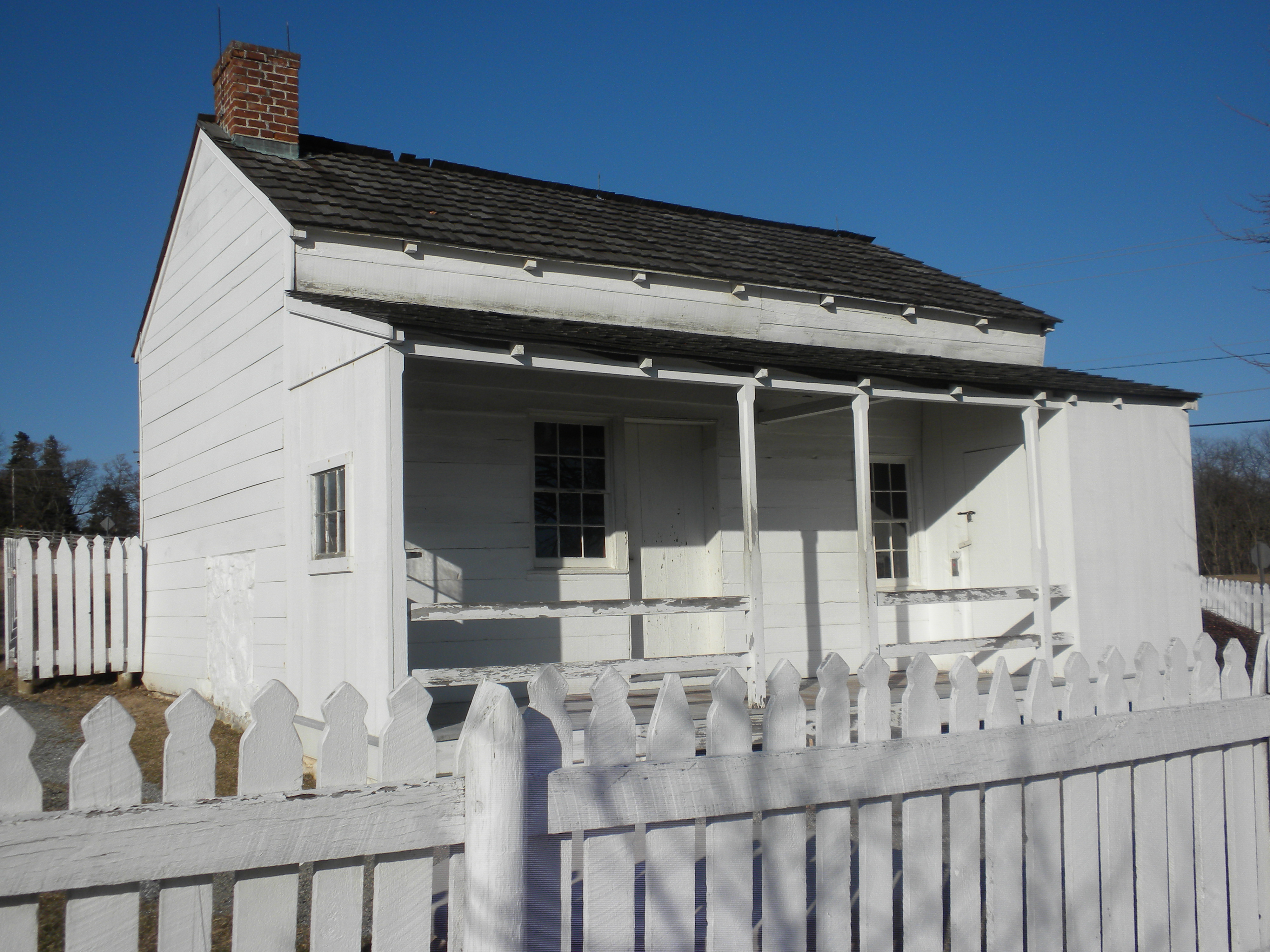
An edited version of this article appeared as the first of a series I wrote for Civil War Times magazine, beginning in the June 2010 issue. The column was first called In Harm’s Way, and later as Collateral Damage.
The Leister House
The Leister house is best known for serving as the headquarters of Union Major General George Gordon Meade during the battle of Gettysburg – particularly as the site of the famous council of war held in its cramped interior on the evening of July 2, 1863.
The 1.5 story log house on Taneytown Rd. south of the town of Gettysburg was built no later than 1840, by Thomas Nolan. The farm at 10 acres was small for the day, as was the house at about 390 square feet plus floored attic. The main living area consisted of two rooms: a kitchen and a living/bedroom. Nolan sold the farm to Henry Bishop, Sr. in 1840, and Lydia (Study) Leister purchased it from Bishop for $900 on March 30, 1861, apparently with funds left her by her father but held in trust until her alcoholic husband’s death. Lydia and her husband James moved to the Gettysburg area from Maryland in 1850, and James died on Dec. 11, 1859, leaving behind his wife and six children, at least two of whom were living with Lydia on the farm at the time of the battle.
On July 1, 1863, Lydia and young Hannah and Matilda were advised by a mounted Union officer to leave the farm for their safety. They eventually found shelter on the Baltimore Road. The farm’s location was ideal for communications; the house and outbuildings were occupied and the grounds used as a signal station, the fields crossed frequently by troops, messengers and staff. On July 2nd and 3rd, Meade established his headquarters there. By the afternoon of the 3rd, it was being used as an aid station. Gettysburg resident Daniel Skelly visited the farmhouse on July 6th:
“In the front room of the house was a bed, the covers of it thrown back; and its condition indicated that a wounded soldier had occupied it. I was told that General Butterfield, Meade’s chief of staff, who had been wounded, had been placed upon it before being taken to a hospital.”
When Lydia and her children returned, they were greeted with devastation. In 1865 she described the scene to author John T. Trowbridge:
“I owed a little on my land yit, and thought I’d put in two lots of wheat that year, and it was all trampled down, and I didn’t get nothing from it. I had seven pieces of meat yit, and them was all took. All I had when I got back was jest a little bit of flour yit. The fences was all tore down, so that there wasn’t one standing, and the rails was burnt up. One shell came into the house and knocked a bedstead all to pices for me…The porch was all knocked down. There was seventeen dead horses on my land. They burnt five of ‘em around my best peach tree and killed it; so I ha’n’t no peaches this year. They broke down all my young apple trees for me. The dead horses sp’iled my spring, so I had to have my well dug.”
Trowbridge reflected on Leister:
“This poor woman’s entire interest in the great battle was, I found, centered in her own losses. That the country lost or gained she did not know or care, never having once thought of that side of the question.”
Lydia was eventually able to repair her house, even building a two story addition. She also expanded the farm, purchasing additional acreage from neighbor Peter Frey. She sold the bedroom table used by Meade during his stay to an Edmund Cleveland of Elisabeth, NJ (the table subsequently made its way back to the Park’s collection), and also sold for fertilizer the 750 pounds of bone from the dead horses, from which it took over 18 months for the meat to rot. She lived on the farm until 1888, when poor health caused her to move into town. At that time, the Gettysburg Battlefield Preservation Association purchased the farm from Lydia for $3,000.
The original farm house was lived in continually by tenant farmers into the 1920’s. In 1933 the property was taken over by the National Park service, at which time it ceased to operate as a tenant farm and the buildings used for storage. In 1961, extensive excavation and reinforcement of the foundation was done, and the house was fully restored in 1966.
Upon selling her farm to the GBPA, Lydia had the two-story addition removed to a lot she purchased in town. She lived in that dwelling, which today is known as the Gettystown Inn near the Dobbin House on Steinwehr Ave., until her death at the age of 84 on Dec. 29, 1893, and is buried in Gettysburg’s Evergreen Cemetery. Over the years Lydia Leister had filed claims against the War Department totaling just over $1,311 for damages to her farm during the battle. Settlement was made for $52.50.
[See here for some photos of the Leister house and farm. Thanks to GNMP and Ranger Troy Harmon for access to the house on a very, very cold day.]
Sources: Gettysburg National Military Park files; http://www.dobbinhouse.com; National Park Service Cultural Resources Management Bulletin Vol. 5, #4, December 1982, “The Mystery of General Meade’s Table,” Ronald Sheetz, http://crm.cr.nps.gov/archive/05-4/5-4-all.pdf; “A Strange and Blighted Land,” Gregory Coco; “A Vast Sea of Misery,” Gregory Coco; “The South: A Tour of its Battle-Fields and Ruined Cities,” John T. Trowbridge.


 I last wrote about my recent foray into popular history works concerning the American Civil War
I last wrote about my recent foray into popular history works concerning the American Civil War 




Recent Comments